How to Build an Inclusive Business Culture
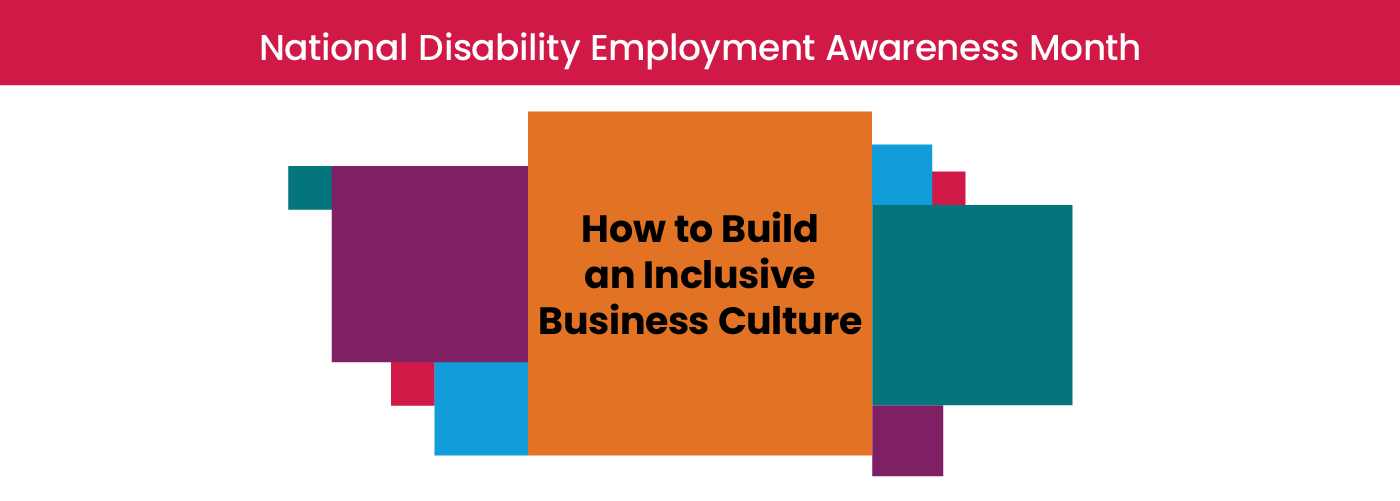
Myths and stereotypes continue to create barriers to employment opportunities for qualified people with disabilities. Sixty-one million adults in the United States live with a disability (CDC), yet only one in three (34%) individuals with disabilities are employed compared to 76% of their counterparts without disabilities.
Building a disability-inclusive workplace culture enables your organization to reach this large demographic of underserved workers. With equal employment opportunity initiatives, compelling messaging, and outreach, businesses can successfully recruit, hire, retain and advance workers with disabilities at all levels.
According to the Journal of Business and Psychology, managers hiring people with disabilities are encouraged by the presence of formal disability hiring policies and training specifically focused on hiring and retaining workers with disabilities.
Here are a few ways to begin building an inclusive business culture:
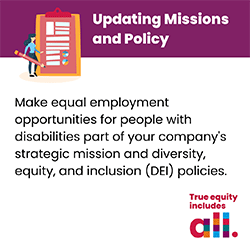 Missions and Policy
Missions and Policy
Make equal employment opportunities for people with disabilities a part of the company's strategic mission. Develop policies that communicate a commitment and include workers with disabilities in the company's diversity, equity, and inclusion (DEI) policies and activities.
Supportive Teams
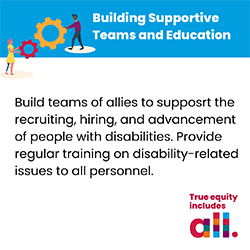 Build teams of allies, including executives, managers, and employees with disabilities, to support the recruiting, hiring, and advancement of people with disabilities.
Build teams of allies, including executives, managers, and employees with disabilities, to support the recruiting, hiring, and advancement of people with disabilities.
Education
Companies committed to disability inclusion regularly communicate and educate employees to reinforce that commitment. Provide regular training on disability-related issues to all personnel, specifically those involved in recruitment, hiring, promotion, and retention processes.
Communication
How an organization communicates about the inclusion of people with disabilities can impact its ability to attract and retain employees with disabilities. Consumers evaluate organizations that hire people with disabilities more favorably than those that do not.
Learn how to effectively communicate your organization's commitment to disability inclusion as a part of an overall DEI strategy that includes accessibility goals (DEIA).
Make and publicize the "business case" for hiring people with disabilities. Return on investment and benefits include higher productivity, lower absenteeism and turnover, and increased employee morale—for all employees.
Recruitment and Accessibility
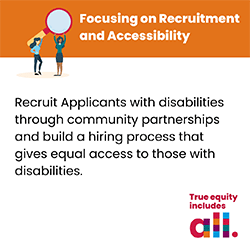 Stereotypes portray workers with disabilities as less productive than employees without disabilities. However, the Journal of Business and Psychology found that individuals with disabilities are more productive in some instances, and they do not experience higher levels of lateness or absenteeism.
Stereotypes portray workers with disabilities as less productive than employees without disabilities. However, the Journal of Business and Psychology found that individuals with disabilities are more productive in some instances, and they do not experience higher levels of lateness or absenteeism.
Build a hiring process accessible to those with disabilities. Audit the digital recruiting screening systems to determine if qualified applicants with disabilities have equal access.
With intentional partnerships, companies can successfully build a pipeline of applicants with disabilities, which is key to ongoing outreach and recruitment.
As a result, companies can find the talent they may have overlooked and other personnel benefits from effectively integrating people with disabilities into their workforce.
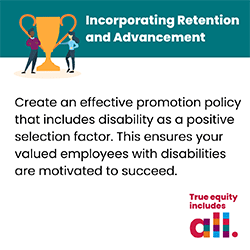 Retention and Advancement
Retention and Advancement
Disability inclusion also means what happens after hiring. Employers must take steps to retain valued employees with disabilities and ensure equal opportunity to advance and grow. Finally, create an effective promotion policy that includes disability as a positive selection factor.
Reasonable Accommodations
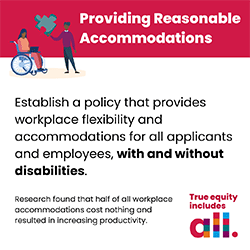 According to AskEARN, reasonable accommodations, occasionally called "workplace accommodations," include assistive technology or adaptive equipment.
According to AskEARN, reasonable accommodations, occasionally called "workplace accommodations," include assistive technology or adaptive equipment.
Reasonable accommodations may include flexible work arrangements such as flextime or telework or schedule adjustments for medical appointments. In addition, the Job Accommodation Network (JAN) notes that more than half of all workplace accommodations cost nothing.
Furthermore, JAN's statistics report that employers note financial benefits and increased productivity.
Evidence suggests accommodations improved interactions between employees with disabilities and their coworkers as well as increased company morale. Establish a policy that provides workplace flexibility and accommodations for all applicants and employees, with and without disabilities. Accommodations signal that the organization values workers' contributions and cares about workers' well-being, leading to long-term commitment and tenure.
Accountability
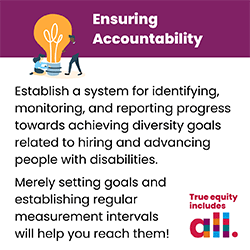 How do companies assess and determine if their current policies and procedures improve employment opportunities for persons with disabilities? Accountability.
How do companies assess and determine if their current policies and procedures improve employment opportunities for persons with disabilities? Accountability.
- Audit and review employment-related activities
- Conduct annual assessments
- Seek input from employees with disabilities regarding policies and develop strategic plans to address any noted deficiencies
- Provide regularly scheduled reports
- Establish a system for identifying, monitoring, and reporting
- Establish a complaint resolution process that is efficient, fair, and impartial
Studies show people with and without disabilities attach the same significance to work-related outcomes such as job security, income, and promotion opportunities.
Despite advancements in diversity, inclusion, and equity (DEI) in the workplace, obstacles remain in accepting and advancing individuals with disabilities. Representing different ages, genders, and ethnic backgrounds, workers with disabilities can offer companies a competitive edge. Individuals with disabilities are experienced problem solvers who develop creative business solutions, add value to a business and enhance workforce diversity.
You can also find more information at SHRM Employing Abilities at Work Program website.
Need More Info?
Email Marketing Communications
Enjoy this? You might like these stories, too: